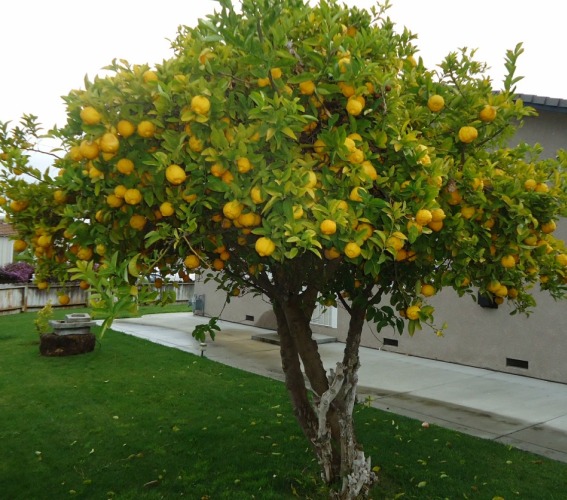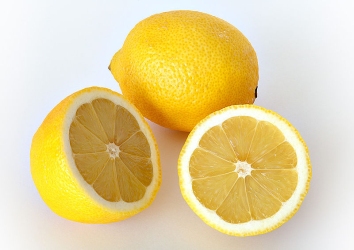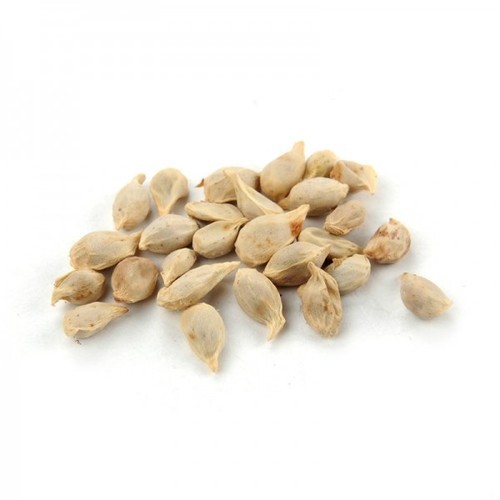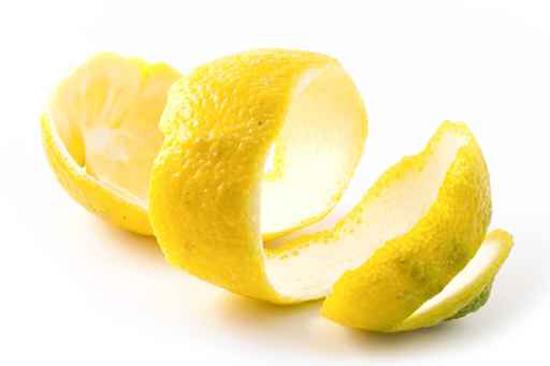 Citrus
limon. 柠
檬 Níng
méng Lemon Family:
Rutaceae
Citrus
limon. 柠
檬 Níng
méng Lemon Family:
Rutaceae
 Citrus
limon. 柠
檬 Níng
méng Lemon Family:
Rutaceae
Citrus
limon. 柠
檬 Níng
méng Lemon Family:
Rutaceae


 柠
檬
皮 Níng méng pí Lemon
skin
柠
檬
皮 Níng méng pí Lemon
skinThe hypocholesterolemic effect of lemon peels, lemon pectin, and the
waste stream material of lemon peels in hybrid F1B hamsters.
Terpstra AH, Lapré JA, de Vries HT, Beynen AC.
Abstract
BACKGROUND:
We found in preliminary studies with hamsters that citrus peels have a cholesterol
lowering effect comparable to that of pectin extracted from these peels.
AIM OF THE STUDY:
We wanted to examine whether the cholesterol lowering effect of the peels could
be completely accounted for by the pectin in the peels.
METHODS:
We fed cholesterol enriched (0.1 %,w/w) semipurified diets containing 3% (w/w)
of cellulose, lemon peels, lemon pectin, and the waste stream material of the
lemon peels to hybrid F1B hamsters for a period of 8 weeks. The waste stream
of the lemon peels is the left over after extraction of the lemon pectin.
RESULTS:
Feeding the semipurified diets resulted in an increase of plasma cholesterol
levels in all the dietary groups after 2 and 4 weeks on the diets. Cholesterol
concentrations in the cellulose fed hamsters continued to increase after 4 weeks
on the diet, whereas cholesterol levels in the other groups had reached a plateau.
As a consequence, the plasma cholesterol levels in the hamsters fed the peels
(5.59 +/- 0.74 mmol/L, mean +/- SD, n = 14), pectin (5.19 +/- 0.48 mmol/L),
or waste stream (5.53 +/- 0.94 mmol/L) were lower than those in the hamsters
fed cellulose (6.71 +/- 1.52 mmol/L) after 8 weeks on the diets. Differences
in total plasma cholesterol were reflected in differences in both VLDL and LDL
cholesterol concentration, but this effect was more distinct for the VLDL. There
was no effect of the type of fiber on HDL cholesterol levels. Liver cholesterol
concentrations paralleled. the concentrations of plasma cholesterol and the
liver cholesterol concentrations in the hamsters fed the peels (3.57+/- 1.01
micromol/g liver, mean +/- SD, n = 14), pectin (4.86 +/- 1.42), and the waste
stream (4.96 +/- 1.89) were lower than those in the cellulose group (7.19 +/-
2.32). The hamsters fed the peels, pectin, or waste stream tended to have a
higher excretion of fecal bile acids and neutral sterols then the cellulose
fed hamsters.
CONCLUSION:
The results of this study suggest that lemon peels and the waste stream of the
lemon peels are as effective in lowering plasma and liver cholesterol in hamsters
as the pectin extracted from the peels and that also compounds other than pectin
are probably responsible for the cholesterol lowering effect of the citrus peels.Eur
J Nutr. 2002 Feb;41(1):19-26. ncbi.nlm.nih.gov
Lemon oil vapor causes an anti-stress effect via modulating the 5-HT
and DA activities in mice.
Komiya M, Takeuchi T, Harada E.
Abstract
We examined the anti-stress action of the essential oils of lavender, rose,
and lemon using an elevated plus-maze task (EPM), a forced swimming task (FST),
and an open field task (OFT) in mice. Lemon oil had the strongest anti-stress
effect in all three behavioral tasks. We further investigated a regulatory mechanism
of the lemon oil by pre-treatments with agonists or antagonists to benzodiazepine,
5-HT, DA, and adrenaline receptors by the EPM and the FST. The anti-stress effect
of lemon oil was significantly blocked by pre-treatment with frumazenil, benzodiazepine
receptor antagonist, or apomorphine, a nonselective DA receptor agonist. In
contrast, agonists or antagonists to the 5-HT receptor and the alpha-2 adrenaline
receptor did not affect the anti-stress effect of lemon oil. Buspirone, DOI,
and mianserine blocked the antidepressant-like effect of lemon oil in the FST,
but WAY100,635 did not. These findings suggest that the antidepressant-like
effect of lemon oil is closely related with the 5-HTnergic pathway, especially
via 5-HT(1A) receptor. Moreover, the lemon oil significantly accelerated the
metabolic turnover of DA in the hippocampus and of 5-HT in the prefrontal cortex
and striatum. These results suggest that lemon oil possesses anxiolytic, antidepressant-like
effects via the suppression of DA activity related to enhanced 5-HTnergic neurons.Behav
Brain Res. 2006 Sep 25;172(2):240-9. Epub 2006 Jun 15. ncbi.nlm.nih.gov
Citrus lemon essential oil: chemical composition, antioxidant and antimicrobial
activities with its preservative effect against Listeria monocytogenes inoculated
in minced beef meat
Anis Ben Hsouna, Nihed Ben Halima,corresponding author Slim Smaoui, and Naceur
Hamdi
Abstract
Background
Lemon (Citrus limon) is a flowing plant belonging to the Rutaceae family. Citrus
plants constitute one of the main valuable sources of essential oil used in
foods and medicinal purposes.
Methods
In this study, we assessed chemical composition, antioxidant and antimicrobial
activities of C. limon essential oil (ClEO) with its preservative effect against
Listeria monocytogenes inoculated in minced beef meat. Gas chromatography/mass
spectrometry (GC-MS) was used to identify the major components of the obtained
ClEO. The antioxidant activities of this ClEO were determined according to the
ß-carotene bleaching assay, as well as by 2.2-diphenyl-1-picrylhydrazyl (DPPH)
radical scavenging activity. For antimicrobial activity, agar well diffusion
method was used and the minimum inhibitory concentrations (MICs) as well as
the minimum fungicidal concentrations (MFCs) were determined. The in situ effect
of the ClEO was evaluated through physicochemical parameters (pH and thiobarbituric
acid reactive substances (TBARS), as well as against L. monocytogenes in minced
beef meat model.
Results
Twenty one components were identified in the ClEO and the two dominant compounds
were limonene (39.74%) and ß-Pinene (25.44%). This ClEO displayed an excellent
DPPH scavenging ability with an extract concentration providing 50% inhibition
(IC50) of 15.056 µg/ml and a strong ß-carotene bleaching inhibition after 120
min of incubation with an IC50 of 40.147 µg/ml. The MICs varied from 0.039 to
1.25 mg/ml for Gram positive bacteria and from 0.25 to 2.5 mg/ml for Gram-negative
bacteria. The meat preserving potential of ClEO was investigated against L.
monocytogenes. ClEO successfully inhibited development of L. monocytogenes in
minced beef meat. The application of ClEO at a 0.06 and 0.312 mg/g, may open
new promising opportunities for the prevention of contamination from and growth
of pathogenic bacteria, particularly L. monocytogenes, during minced beef meat
storage at 4 °C. Additionally, during storage period, physicochemical values
(pH and TBARS) were higher in control meat than treated meat with ClEO suggesting
an efficient antioxidant activity of ClEO.
Conclusion
It was suggested that the ClEO may be a new potential source as natural antimicrobial
and antioxidant agents applied in food systems and pharmaceutical industry.
Lipids Health Dis. 2017; 16: 146.
Published online 2017 Aug 3. doi: 10.1186/s12944-017-0487-5
PMCID: PMC5543433
PMID: 28774297 hncbi.nlm.nih.gov
Lemon oil vapor causes an anti-stress effect via modulating the 5-HT
and DA activities in mice
Migiwa Komiya, Takashi Takeuchi, Etsumori Harada
Abstract
We examined the anti-stress action of the essential oils of lavender, rose,
and lemon using an elevated plus-maze task (EPM), a forced swimming task (FST),
and an open field task (OFT) in mice. Lemon oil had the strongest anti-stress
effect in all three behavioral tasks. We further investigated a regulatory mechanism
of the lemon oil by pre-treatments with agonists or antagonists to benzodiazepine,
5-HT, DA, and adrenaline receptors by the EPM and the FST. The anti-stress effect
of lemon oil was significantly blocked by pre-treatment with frumazenil, benzodiazepine
receptor antagonist, or apomorphine, a nonselective DA receptor agonist. In
contrast, agonists or antagonists to the 5-HT receptor and the alpha-2 adrenaline
receptor did not affect the anti-stress effect of lemon oil. Buspirone, DOI,
and mianserine blocked the antidepressant-like effect of lemon oil in the FST,
but WAY100,635 did not. These findings suggest that the antidepressant-like
effect of lemon oil is closely related with the 5-HTnergic pathway, especially
via 5-HT(1A) receptor. Moreover, the lemon oil significantly accelerated the
metabolic turnover of DA in the hippocampus and of 5-HT in the prefrontal cortex
and striatum. These results suggest that lemon oil possesses anxiolytic, antidepressant-like
effects via the suppression of DA activity related to enhanced 5-HTnergic neurons.
Article in Behavioural Brain Research 172(2):240-9 · October 2006 with 127 Reads
DOI: 10.1016/j.bbr.2006.05.006 · Source: PubMed 32.61Tottori University researchgate.net